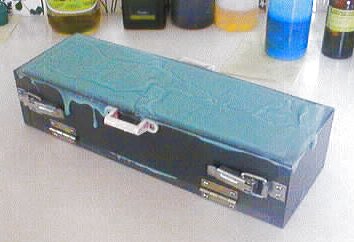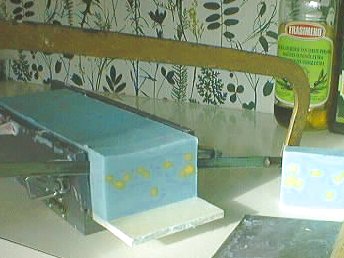

Cold Process Soaps,
|
Manufacturing of soaps is always a very exciting experience for the amateur. Will it be successful this time or will it end up again as a unusable mash? Our great-grandmothers were also never sure, if their soaps would ever harden, if they were too caustic or too oily. Countless recipes and methods have been passed on, and as many countless more or less useful results can be obtained that way.
With a bit more systematic approach one can distinguish several soap-making processes, which all have their advantages and disadvantages.
- Curd Soap Process
- Cold Process, CP
- Hot Process, HP
- Remelting, Rebatching
The most popular process amongst amateurs is cold stirring or cold soap-making, which actually doesn’t happen at such low temperatures, considering that temperatures up to 85°C (185°F) can be reached.
Starting Materials
For soap production one either uses only vegetarian oils and fats or a mixture of suet or lard with canola oil, olive oil, coconut oil or other oils. Natural fats and oils contain many different types of oil, which themselves have greatly varying properties concerning hardness, lathering and stability. Thus one can influence the properties of a finished soap by the choice of suitable mixing ratios.
Fats and oils are mixed with caustic soda (NaOH). It is important to choose the right mixture. Any oil requires a certain amount of lye to be able to make soap, which is neither too alkaline (caution: caustic ) nor too oily. With too low amounts of lye not all oils can be saponified and the soap will be greasy . Exact tables are now available to the practicioner. With a little computing effort the exact amount of lye can be determined very accurately.
Saponification
After mixing fat and lye at around 50 to 60°C (120 - 140°F) the lengthy process of saponification starts. Already our ancestors knew that ‘soap boilers’ were boring. This was no surprise, considering that one used to stir soaps for hours. Today this can be done much faster. Many use a stick blender for faster and safer stirring, thereby reducing the whole processing time to half an hour and less.
The secret of hand-made soaps is partly due to this cold process. Fats and oils chemically consist of fatty acids and glycerine. Three fatty acid molecules attach themselves to one molecule of glycerin. Therefore one also speaks of triglycerides. During saponification this fat molecule splits, the three fatty acid parts combine with a lye molecule and thus form a ‘salt’ from acid and lye, in other words a soap molecule. Glycerine is left over. The soap industry separates this glycerine by washing out, because it is too valuable and can be reused elsewhere. In the cold process the natural glycerine remains in the soap and can develop its properties. This is the reason, why cold-stirred soaps are much milder and also softer than the industrially produced ones.
Addition of conditioning Oils
After saponification has started, the mass thickens more and more like apple sauce. The soap maker will have to grasp the right moment to add his mixture of conditioning oils to make a superfatting soap – not too soon and not too late. If done too soon then the precious superfatting oils will be converted to soap; if done too late one gets a crumbly mass, which can hardly be put into the mould free of blow holes and homogeneously.
Here are some of the frequently used conditioning oils:
Addition of Colorants
At least now, if not earlier, we can add colorants or dyes to the soap mass. Using stable pigments, which also do not change their colour in the lye, one can already after the first stirring of fat and lye start with coloring. Basically one does not need to color soap, unless one wants to make visually pleasing products. The natural color of cold stirred soap is more or less yellowish. By adding opaque white (titanium oxide) one can design a whiter tone. The amount of color added usually is very small, in the range of per mils. Still, one should make sure to only use those colors which can also be washed off. What is the good use of a beautiful red soap, if you end up with red hands and red towels? Food colors are therefore unsuited most of the time. But specialised trade offers stable pigments, which do not penetrate the skin and only tint the soap.
Addition of Fragrance and Essential Oils
A good soap must also smell good. We are used to this, although no medical reasons are known. Many soap producers combine their products with experiences from aroma therapy. The well-being of many people is strongly influenced by aromas; one can make use of this and add those aromas to the soap, which the customer loves, and which affect him positively.
Unfortunately most of the time finished soaps smell completely different from the good and expensive fragrance, which has been added. Also often the alcohol content of most perfumes leads to cords in the soap. This can look aesthetically pleasing, or it can terribly frustrate a soap perfectionist. Here only trial and error and gaining of experience will help. Aromas actually have to be composed. It is like painting with colors or composing with notes. Only the chord is interesting, the single note can be too loud and to flashy . A flowery smell combined with others, e.g. more fruity smell can give a completely new and interesting aroma.
Amateurs like the most essential oils. It is best to buy pure plant extracts or aromatic additives extracted from plants and to combine them. These sometimes can be quite expensive. For example, best Bulgarian rose oil is comparable in price with gold. But often the amount does not determine the quality. By adding 2 to 3% of good essential oil to the soap one will get a gently smelling soap also after several months of storage time . Too much is unhealthy, and there are enough reports about allergic reactions to certain odors.
Moulding
If finally all the oils and pigments have been stirred into the soap without letting it get too cold or to solid, the mass should be cast quickly into a mould. The mould can be covered with vaseline before, since nothing is more frustrating if one cannot remove the finished soap afterwards. Many soap manufacturers prefer a box-shaped mould, which can take 1 to 2 litres of soap mass. The mould can be preheated to prevent premature solidification at the surface. The mass must be free of blow holes after pouring. Strong knocking can sometimes help.
The picture shows a practical mould, which can be quickly disassembled in order to remove the soap block. Afterwards it can be further cut into single pieces with a tensioned wire or with a thin steel band, as shown in the right picture.
 |
 |
Ageing in the Oven
The shaped mass still is not a real soap. Although oil and lye have been mixed well, no ‘soap crystals’ have been formed yet, e.g. the soap molecule has not yet become stable. Soap formation is an exothermic process. Heat is generated leading to an independent heating of the shaped mass.
This process can be started easily by putting the mould into a preheated oven. But don’t overdue it – soap is not roast beef.. The maximum air temperature is 90°C (190°F); otherwise the soap will stew and the plastic mould may melt. The normal temperature sensor in the oven may not accurately show the air temperature. It is better to place a thermometer next to the soap. If the thermometer is pushed into the soap mass one will see the temperature rise to about 85°C (185°F). Also the color of the soap may darken; looking closer one may observe that the mass has become transparent. It has reached the gel phase. This is the process one has to wait for. Now the soap ages; soap molecules grow and lead to the desired homogeneous mass. Generally, after the heating process one lets the soap cool down slowly over several hours, until it can be removed from the mould and sliced into smaller pieces.
Post-ageing of the Soap
The still ‘young’ soap may be still too acid for daily use. Chemically it is still too alkaline. A measure for this is the so-called pH-value. For lyes it ranges from pH 7 (neutral) to pH 14 (strong lye). A young soap will have a pH-value ranging from 11 to 12. This can still be very aggressive to a sensitive skin or to the mucosa . After a few days, however, the pH-value will drop to about 9 to 10. This is also the value of commercial soaps, except for those soaps which have been specially made neutral. But those are not really soaps but detergencies.
A longer ageing for weeks and months will dry out the soap. It will shrink a bit and become harder. This is actually wanted. Also the soap should be in form to be stored. With some superfatted soaps fat droplets can appear at the surface. This in itself is not bad, unless it turns rancid . The experienced soap-maker will go against this by adding natural materials, e.g. vitamin E. Many vegetable oils already contain this vitamin. An especially large amount of vitamin E one will find in wheat germ oil . Since this oil is also good for the skin, one can kill two birds with one stone.
Hand-made soaps will not always be light-resistant. If exposed to sunlight they can change color. The soap will turn yellowish, and some color pigments can bleach out. Thus an originally blue soap can turn green or a white soap will become yellow. Often titanium oxide white is added to stabilize the color. It has a strongly coloring effect, as we can see in our beautifully white toothpaste.
Shall One Use Soap Daily?
Caution : Catch-22 question ! Civilized men are known to wash daily and use soap for this. We have learned as children to also wash behind our ears. But do we have to take a bath on a daily basis?
One can seriously ask this question. Physicians have discovered that the human skin acts as an acidic protecting layer. The skin precipitates fats and proteins, which will be fermented to fatty acids by naturally existing lactic acid bacteria. We know this, when, unwashed for several days, we start to smell acid-like. Especially critical is butyric acid, which strongly smells like sweaty feet. Nature has made sure that harmless lactic acid bacteria populate our skin, leaving no space for other, perhaps more evil bacteria. When washing with soap, these proteins, fats and fatty acids will become water soluble and will be washed away. Afterwards man is not only naked, but will be totally exposed to wild attacks by bad bacteria and fungus spores, which now have found space on a skin free of bacteria. If one now uses anti-bacterial soaps it can happen that bacteria become more resistant and can only be removed by even stronger antibiotics. This is serious for people, who like to take one to two showers per day or even a full bath, and will have to fight against annoying rashes or chronic acromycosis.
One to two days after washing with soap the skin will again have this protective layer of fatty acid formed by lactic acid bacteria, which blocks access to germs. Thus one should give the skin a chance to regenerate. It used to be said that one full bath per week, mostly on Saturday evening, is enough. Today, if one doesn’t want to irritate colleagues at work, one will take a shower a few more times, perhaps with hand-made soaps, which are mild and equipped with soft oils and which will again provide a new basis for lactic bacteria to live.
© 2006 by Herald Gessinger
Back to Home Page